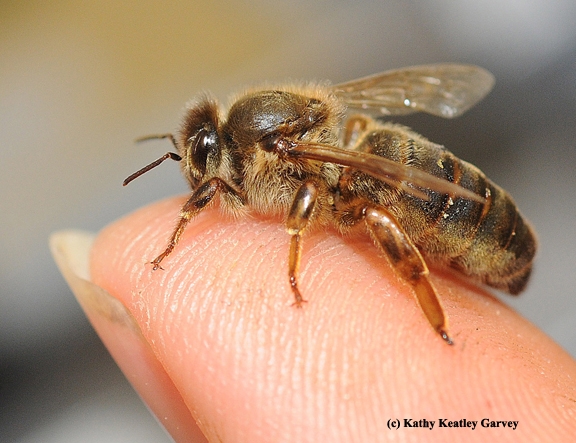If you see a news story about "honey bees" in a newspaper or magazine, odds are you'll see it spelled as one word, "honeybees."
That's because the Associated Press Stylebook, the journalists' "bible," spells it that way. So do dictionaries.
However, in the entomological world, that's incorrect. "Honey bee" is two words because it's a true bee, just like "bumble bee." Similarly, you wouldn't spell "dragonfly" as "dragon fly" because a dragonfly is not a fly.
The Entomological Society of America (ESA) governs the worldwide references to insects in its Common Names of Insects. If you want to know the common name, scientific name, order, family, genus, species and author, the ESA database provides it. Type in a name and a drop-down menu appears. Find the honey bee!
Common name: Honey bee
Scientific name: Apis mellifera Linnaeus
Order: Hymenoptera
Family: Apidae
Genus: Apis
Species: mellifera
Author: Linnaeus
Extension apiculturist Elina Niño of the UC Davis Department of Entomology and Nematology writes about the misspelling in the Kids' Corner of her recent newsletter, from the UC Apiaries. "Since starting my new job at UC Davis, I have been corrected a few times for spelling 'honey bee' as two words rather than 'honeybee,' a single word. What do you think: which one is more appropriate?"
She goes on to explain why "honey bee" is accurate. "Honey bees belong to an order of insects (a group of insects that have several similar features) named Hymenoptera which contains bees, wasps, sawflies and ants. You might even say they are 'true' bees and therefore, should be spelled as two words."
In an article published in a 2004 edition of Entomology Today, the Entomological Society of America's communications program manager Richard Levine acknowledges that "Writing insect names using American English can be difficult. Some species have different names depending on where you are, or with whom you are speaking (think 'ladybug' or 'ladybird' or 'lady beetle'). More often than not, an insect may not even have an official common name because out of the million or so insects that have been discovered and described, only a couple of thousand have been designated with common names by the Entomological Society of America (ESA)."
"To make matters worse," Levine writes, "even the ones that DO have official common names — ones that we see nearly every day — may have different spellings depending on whether they appear in scientific publications or other print media, such as newspapers or magazines."
So the "bible" of journalists--or what the Associated Press sanctions and governs--does not always agree with the scientific "bible" of the entomological community--or what ESA sanctions and governs.
"The reason for the discrepancy is that entomologists use two words if a common name accurately describes the order to which a particular insect belongs," Levine points out. "For example, all true flies belong to the order Diptera, so true fly names will be spelled using two words by entomologists — house fly, horse fly, pigeon fly, or stable fly, for example. However, despite their names, dragonflies and butterflies are NOT true flies — their orders are Odonata and Lepidoptera, respectively — so they are spelled as one word."
As an aside, we wonder if the controversy over the spelling of "honey bee" extends to spelling bees. Would judges eliminate someone for spelling "honey bee" with a space in between? "H-O-N-E-Y (space) B-E-E?"
Still, things can and do change. For years, the AP Stylebook editors insisted that "under take" is two words, not one. They've relented now, and it's one word, "undertake." Glory bee!
Will the AP Stylebook follow the ESA's Common Names of Insects and decide it's "honey bee," not "honeybee?" Will the AP Stylebook give the honey bee some space? Just a little space?
Stay tuned. Or stay buzzed.
Attached Images:
